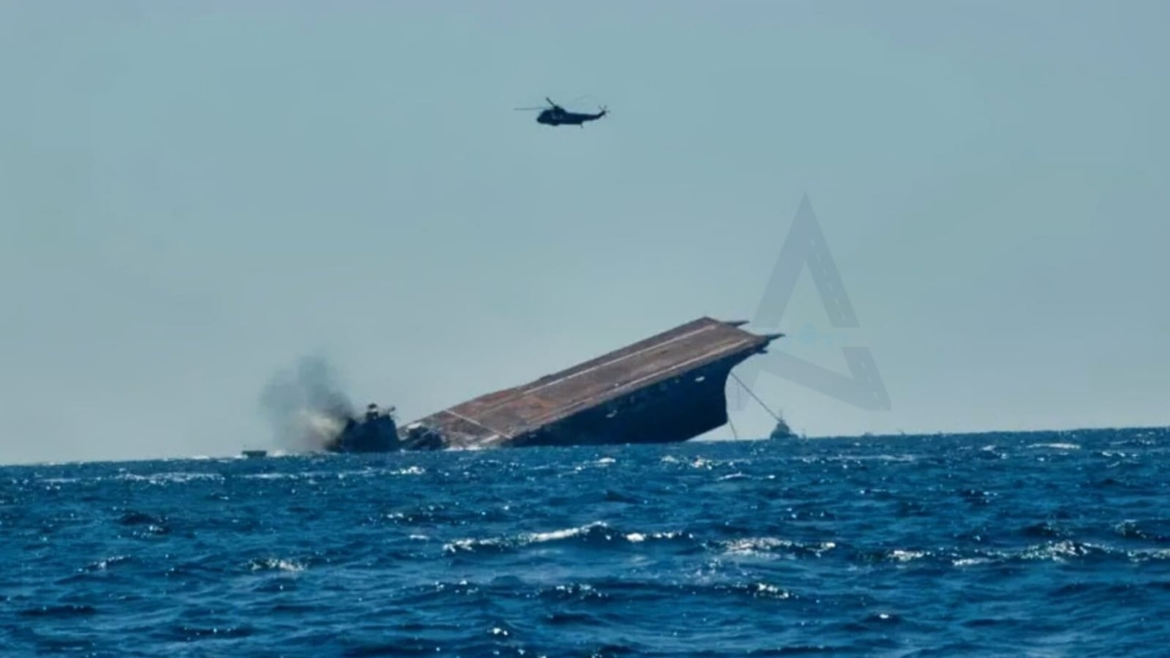The USS America (CV-66), one of the most iconic aircraft carriers of the U.S. Navy, had a storied service history from 1965 to 1996, including participation in pivotal military operations such as the Vietnam War and Operation Desert Storm. After three decades of active service, the ship was retired, but its final mission came long after it had been decommissioned. In 2005, the Navy undertook a unique and challenging operation: sinking its own aircraft carrier as part of a live-fire test designed to evaluate the survivability of modern aircraft carriers under extreme attack conditions.
This extraordinary test was conducted over the course of four weeks and involved subjecting the USS America to a barrage of weapons systems to simulate various wartime scenarios. The operation, known as a “SINKEX” (sinking exercise), was not just an ordinary naval exercise. The Navy sought to gather vital data on how a massive ship like an aircraft carrier would hold up under sustained attack. This test would provide invaluable insights into the vulnerabilities and resilience of carrier designs, particularly in an age when new, more sophisticated threats like anti-ship missiles and advanced torpedoes posed a growing danger to surface ships.
The USS America was chosen for this mission due to its size, similar to modern carriers, and its ability to provide a relevant baseline for studying how such a large warship could survive—or not—when faced with overwhelming force. Throughout the four-week test, the ship was subjected to a range of attacks, including explosive charges placed both on the ship and in the water around it. These charges simulated various potential threats, including missile strikes, torpedo hits, and bomb blasts. The gradual escalation of damage allowed Navy engineers and planners to study the exact points of failure in the ship’s structure and systems.
What made this test even more significant was the decision to conduct the entire operation without a crew on board. The Navy took great care to remove all environmentally hazardous materials from the USS America before the tests, ensuring that the operation had minimal impact on the ocean environment. This allowed for an uncrewed, controlled environment in which the ship could endure extensive punishment over a prolonged period, without the risk to human life.
The experiment was groundbreaking in its scale and ambition. During the testing, engineers were especially interested in how critical areas of the ship, such as the flight deck, hull, and internal compartments, would fare under attack. The flight deck, designed to withstand the weight and impact of launching and recovering aircraft, was of particular interest because it plays a crucial role in a carrier’s ability to continue operating in wartime. The Navy wanted to know how long the ship could keep planes in the air if it came under sustained attack.
Despite the robust design of the USS America, it was evident by the end of the exercise that even the largest and most formidable ships could be vulnerable. It took four weeks of relentless attacks to sink the carrier, a testament to the ship’s structural integrity and the resilience of its systems. The USS America finally succumbed to the damage and sank into the depths of the Atlantic Ocean.
The data collected from the sinking of USS America was invaluable for the future development of U.S. Navy ships, particularly aircraft carriers. Lessons learned from the exercise influenced the design of future carriers, including the Gerald R. Ford-class carriers, which incorporate advanced technology and design improvements aimed at enhancing survivability in combat.
Though some former sailors and veterans who served aboard USS America initially expressed sadness and frustration at the thought of their ship being deliberately sunk, the Navy’s decision to use it in such an important experiment ensured that the carrier continued to serve the nation, even in its final moments. The legacy of USS America lives on, not just in the memories of those who served aboard her, but in the enhanced safety and survivability of future aircraft carriers that will defend U.S. interests around the world.
Ultimately, the four-week effort to sink the USS America served as a critical learning exercise for the U.S. Navy. It underscored the complex balance between the immense power of modern weapons and the resilience required by the platforms designed to withstand them. The ship’s final mission, far from being a quiet end, became a milestone in naval engineering and strategy, contributing to the ongoing evolution of carrier design in the 21st century.

